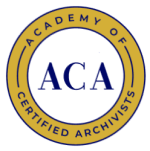Building on a New Foundation
Maygene Daniels, CA
ACA President, 1990-1992
Originally published in “ACA News,” March/April 1999.
In 1989, when the Academy of Certified Archivists was organized at the annual meeting of the Society of American Archivists in St. Louis, it had a new certification examination, developed by the Interim Board on Certification, and a roster of new members. Yet the examination was as yet untested (it was first offered to 21 applicants at the St. Louis meeting) and the organization’s members knew little of the ACA’s future. The task of processing petitions for certification was far from complete, and pressing issues relating to new examination procedures remained to be resolved. The organization had no constitution or bylaws, no tax status, no history, and no stationery.
Greg Hunter and the other ACA officers elected at that St. Louis meeting, who held office during the Academy’s first year, kept the examination process on track, saw the completion of the last petition for membership and began to develop an institutional structure for the Academy. Yet the ACA was still a very young organization when I began my two-year term as ACA’s second president in September 1990. I soon found that far more needed to be accomplished than I or the other new officers and regents imagined.
At that 1990 meeting, the regents set an ambitious agenda: to develop a strategic plan, to increase knowledge of the ACA; to write a handbook of governance practice and precedents.
Most critically, they turned their attention to the certification examination, the core of the Academy’s mission. This was the final year of the ACA’s three year contract with the Professional Examination Service. PES had guided archivists in the rigorous process of developing a documented examination based on broad professional practice. Their work had been impressive. Archivists had defined domains of professional knowledge more clearly than ever before and had developed a bank of questions that could be used to test this knowledge. Yet the costs of the process were high, and the ACA was moving into a new phase in which maintaining and administering the examination were assuming new importance.
The Academy’s officers and regents responded valiantly to these multiple challenges through a mixture of hard work, persistence and humor, coming to think of the ACA as a responsibility whose demands were not less than those of our regular employment, but for which we were not paid. The board’s winter meeting was moved to spring to allow time for needed preparations. Step-by-step, however, sustained, patient work led to very practical results.
After extensive negotiations, PES’s contract was renewed, but for more limited services. Vice-president Deborah Skaggs spent untold hours creating a system to review examination applications, to identify test sites, and to monitor examination development.
Secretary Karen Paul continued her work on another critical function: to ensure that the work of the Academy was understood within the profession and outside. Together with the Membership Development and Outreach Committee, she publicized the examination and began the long process of demonstrating the seriousness and validity of certification.
Treasurer Karen Benedict and the Finance Committee sorted through the difficult financial issues posed by the Academy’s structure and long-term operating costs.
As the ACA confronted its organization and management, it also faced a subject that had been left purposely undefined when it was established: certification maintenance. A renewal process had always been considered an essential part of archival certification, based on the recognition that archivists must remain abreast of new developments and maintain their basic skills if they were to continue to be effective. Yet the organization’s founders also recognized that establishing a system for renewing certification without experience with certification itself would be difficult if not impossible.
By late 1991, the examination process was operating smoothly and the ACA was able to turn its attention to this final element of certification. A task force chaired by Linda Edgerly investigated re-certification in other professions, reviewed certification maintenance proposals and plans, assessed opinion, and prepared a thorough proposal: The ACA’s certification maintenance program, closely based on the committee’s work, was approved in 1992.
Gradually during these months the Academy was organized in other ways as well. Incorporation in the State of Illinois was completed, committees and task forces were established to examine the most pressing issues. When former archivist of the United States James B. Rhoads assumed the ACA presidency in 1992, he accepted responsibility for a still young, but growing organization. Many challenges lay ahead. In its initial organization, a few elected officers had enormous responsibilities. The constitution would soon be revised to ensure greater continuity and a better division of labor. Management of the ACA office and the relationship with a professional testing organization also needed further attention.
Yet already in 1992, the impact of the ACA was beginning to be felt in the profession and beyond. Though much remained to be accomplished, the Academy was built on strong foundations in service to an important professional goal. It is a pleasure now to remember the challenges of those early years, and especially the dedication and vision of my colleagues, who helped make the Academy a reality.
